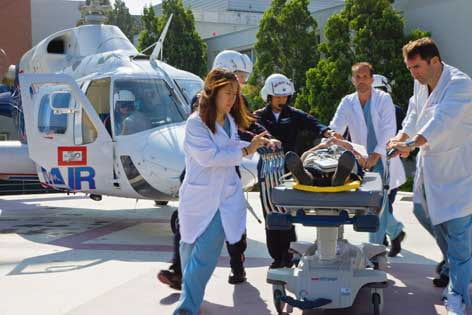Re-verified UCI trauma center plays critical role
UC Irvine Medical Center, Orange County’s only source for Level I trauma care, gets re-certification nod from American College of Surgeons.

In 2008, UC Irvine’s trauma center in Orange treated nearly 2,500 patients. Some had been struck by vehicles or hurt in crashes. Others had fallen or been assaulted. All required care from the most experienced surgeons, nurses and specialists in the crucial minutes and hours after an injury.
“Trauma is the leading cause of death in people ages 1 to 44, more than heart disease and cancer combined,” says Dr. Michael Lekawa, trauma surgeon and director of trauma services at UC Irvine Medical Center. “UCI has made a commitment to provide the most advanced trauma care available to patients with life-threatening injuries.”
The American College of Surgeons recently recognized that commitment by re-verifying that the facility is a Level I trauma center – the only one in Orange County. The designation, which UCI has held since the 1980s, means the medical center addresses every aspect of injury – from prevention to treatment to rehabilitation – and meets the nation’s highest trauma care standards for treating children and adults. There are just 10 such Level I trauma centers in the state.
“UCI’s trauma center is the backbone of Orange County’s emergency medical system,” says Lekawa. “We care for nearly half of the county’s trauma cases each year and are a resource for area hospitals in dealing with the most critical and complicated cases.”
Led by Lekawa, the trauma team includes Drs. Matthew Dolich, Darren Malinoski, Marianne Cinat, Christopher Lane and Cris Barrios. Dr. David Hoyt, chairman of UCI’s Department of Surgery, is one of the country’s top trauma physicians and leads research to improve trauma care across the U.S. All are board-certified in both surgery and surgical critical care.
Key elements of a Level I trauma center are the immediate and around-the-clock availability of general surgeons and the prompt availability of specialists in orthopedic surgery, neurosurgery, anesthesiology, emergency medicine, radiology, internal medicine and critical care.
UCI’s trauma commitment has other benefits. Lekawa says the “halo effect” of having specialists on-site or on call 24/7 is that UCI is also equipped to be a cardiac and stroke-neurology receiving center and is capable of handling more than half of the county’s burn cases at its only ACS-verified regional burn center.
Trauma surgeons also monitor patients’ progress in the new UC Irvine Douglas Hospital’s surgical intensive care unit. This continuum of care is reflected in the case of Jon Wilhite, sole survivor of an April car crash that killed Angels pitcher Nick Adenhart and friends Courtney Stewart and Henry Pearson. UCI’s trauma team treated Wilhite’s life-threatening injuries for a week before he was stable enough for another UCI surgeon to perform the operation that will allow him to lead a normal life.
The trauma center also furthers UCI’s mission to teach the next generation of physicians. More than 30 surgical residents at a time undergo intensive training in trauma/critical care, including rotations in the center. UCI was among the first in the nation to provide such specialized medical training and offers Orange County’s only critical care fellowship.
“Just about every emergency room in the county has a surgeon trained at UCI,” Lekawa says.
UCI was designated a trauma center in 1982, when Orange County started the country’s first regional trauma system to include all of a county’s hospitals and ambulance services. Verified centers must continue to meet stringent ACS criteria to ensure the highest level of function.
“Our Level I re-verification from the American College of Surgeons,” Lekawa says, “confirms that UCI has the resources to provide the best care possible in a medical emergency.”